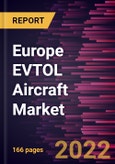The growing emission from transportation is polluting the environment ecosystem, which is further creating the demand for alternative transportation modes. Electric aircraft and flying taxis are among the most preferred alternatives for protecting the environment. Also, the vehicle could be designed as per different weather conditions. Therefore, the aviation market would witness a new era of electrified and hybrid aircraft propulsion in the coming years. Urban air mobility is increasingly seen as the future for rapid, sustainable, and affordable intercity travel. Some market players are looking to launch their services by the end of 2022. As battery technology improves, air taxis and other eVTOL vehicles will become sustainable and fly for longer ranges and at higher speeds. At present, eVTOL aircraft run purely on batteries, which are clean, quiet, and efficient source of power. Further, charging of batteries using renewable energy sources will help environment progress toward the goals of achieving zero emissions and keep global temperature within the emission standards. Several companies are working on technologies that can provide higher energy and power density than the present lithium-ion batteries. A few companies are working on lithium-sulfur (Li-S) battery technology. For instance, OXIS Energy has already achieved 450wh/kg at the cell level and expects to achieve 600wh/kg by 2025. Another emerging technology is the solid-state battery. In lithium-ion batteries, the liquid electrolyte is replaced with a solid electrolyte. This type of battery is reported to be safer, offer a long-life cycle, and have a faster recharge time. A glass solid-state battery can have three times higher energy density than lithium-ion. However, these batteries are still in the research stage at cell level. The low noise emissions are one of the key enablers for the entire eVTOL industry. Low noise is crucial to community acceptance and access spots in urban environments where take-off and land are expected. Thus, Lilium, a leading eVTOL manufacturer, uses ducted electric vectored thrust (DEVT) technology. The jets have ducted fan engines powered by electric motors. Acoustic liners around the fans capture and dissipate much of the noise. The test conducted showed that the perceived noise level of the jet had reduced to a great extent. Thus, the emerging trend for adopting green energy-based transportation and its associated advantages are anticipated to create a demand for eVTOL aircraft in the coming years. The eVTOL aircraft could become the future of passenger travel, military and defense applications, and freight and package transportation. Thus, the growing preference for an alternative transportation mode is expected to offer numerous growth prospects for the eVTOL aircraft market in the coming years.
With the new features and technologies, vendors can attract new customers and expand their footprints in emerging markets. This factor is likely to drive the Europe eVTOL aircraft market . The Europe eVTOL aircraft market is expected to grow at a good CAGR during the forecast period.
Europe eVTOL aircraft market Segmentation
The Europe eVTOL aircraft market is segmented into lift technology, propulsion type, application, operation mode, and country.- Based on lift technology, the Europe eVTOL aircraft market is segmented into multirotor, lift plus cruise, vectored thrust, and others. The lift plus cruise dominates the Europe eVTOL aircraft market in 2024.
- Based on propulsion type, the Europe eVTOL aircraft market is categorized into hybrid, fully electric, and electric hydrogen. The fully electric segment dominates the Europe eVTOL aircraft market in 2024.
- Based on application, the Europe eVTOL aircraft market is categorized into air taxi, Cargo Transport, last mile delivery, critical missions, inspection, surveying and mapping, and others. The air taxi segment dominates the Europe eVTOL aircraft market in 2024.
- Based on operation mode, the Europe eVTOL aircraft market is categorized into piloted, optionally piloted, and autonomous. The piloted segment dominates the Europe eVTOL aircraft market in 2024.
- Based on country, the Europe eVTOL aircraft market is segmented into Germany, France, Italy, UK, Russia, and Rest of Europe. The Germany segment dominates the Europe eVTOL aircraft market in 2024.
Table of Contents
Companies Mentioned
- Airbus
- Bell Textron Inc.
- Boeing
- Eve Air Mobility
- Lilium GmBH
- EHang
- Pipistrel Group
- Volocopter GmBH
- Heart Aerospace
- Archer Aviation Inc








